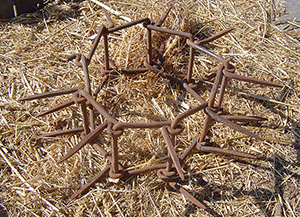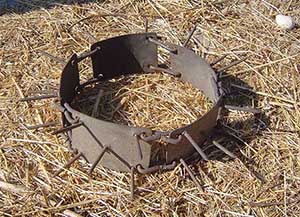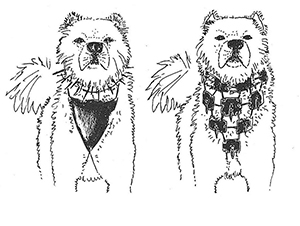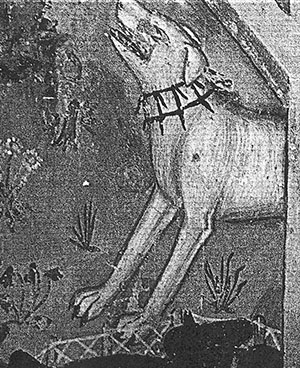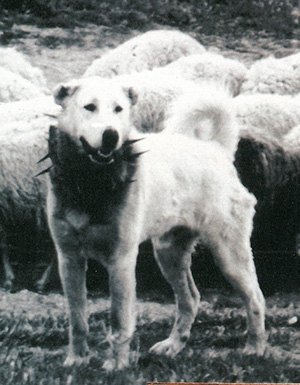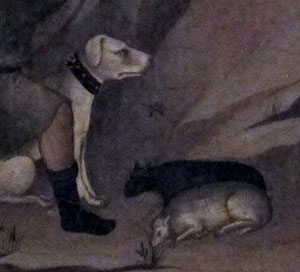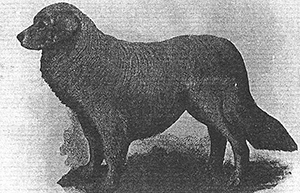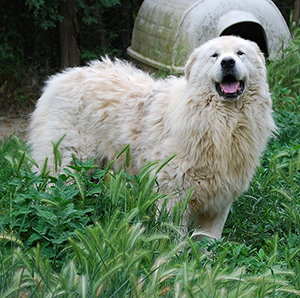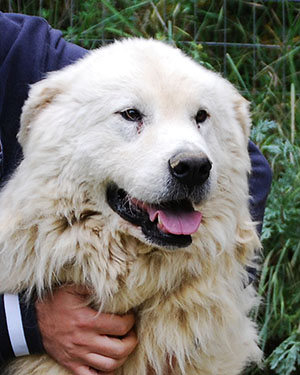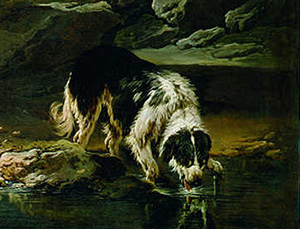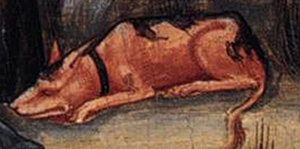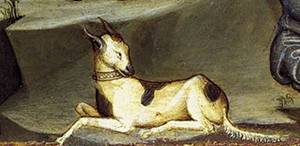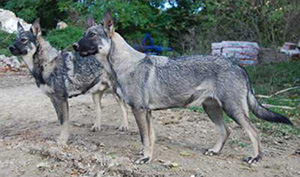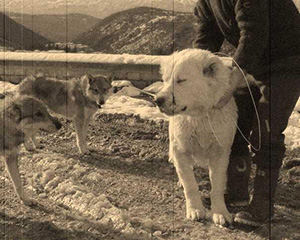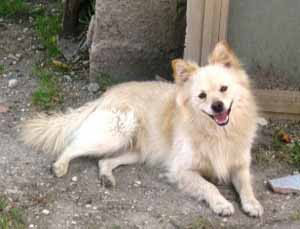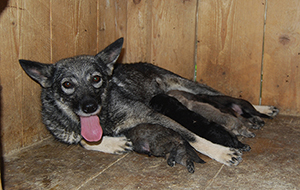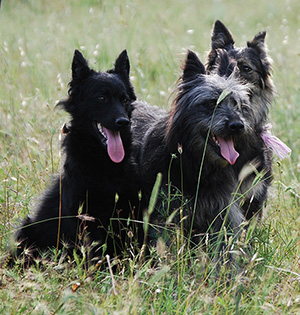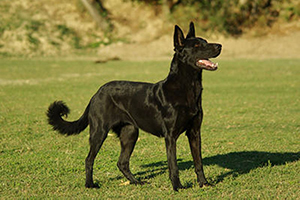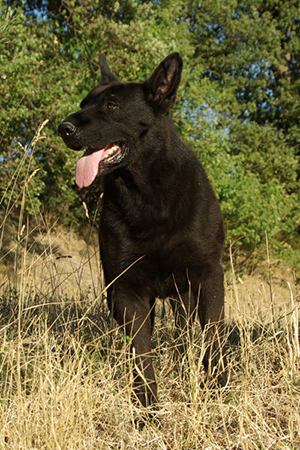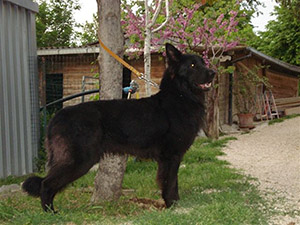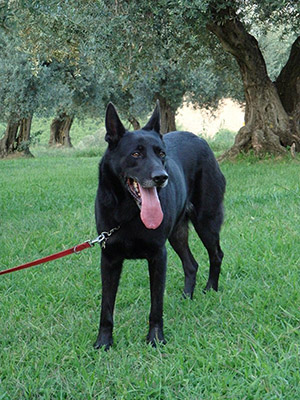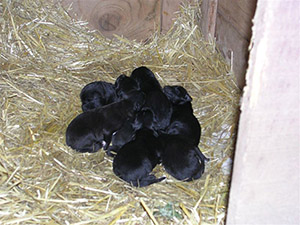THREE ANCIENT ITALIAN DOG BREEDS
by Alberto Bertelli
Italy boasts a very ancient pastoral tradition, especially in the central-southern area; the sheep-rearing is inseparable from the aid of the sheepdogs, so the Italian territory was characterized by the presence of specialized sheepdog breeds since the ancient times.
In this article, three sheepdog breeds typical of Central Italy will be introduced; they are not recognized by the FCI but they are of ancient heritage: the Abruzzese Mastiff (Mastino Abruzzese), the Italian Paratore Dog (Cane Paratore Italiano) and the Italian Shepherd (Pastore Italiano), also paying attention to some zootechnical and ethological aspects.
Italy was the object of three migratory waves of Indo-European warrior-shepherds during the Copper Age and the Bronze Age, between the III millennium BC and 900 BC
It is not excluded however that the sheep-rearing was already known by the Italic peoples before: for example, the Liguri (singular = "Ligure"), population of farmers/breeders migrated from the Iberian peninsula according to the current thesis, took position in northern Italy before the advent of the Indo-Europeans; also, according the fragment 55 of Hesiod (Hesiodus VIII BC - VII B: C.) quoted by Strabo (Strabo ante 60 BC â 23 A. D.; Geografia, IV, V VII), they would be the most ancient civilization of Western Europe; the thesis is confirmed by modern studies.
In particular the central Italy, territory in which the breeds presented in this article developed and evolved, was inhabited since X century BC by the Piceni (singular = "Piceno"), Indo-European origin: the archaeological finding of instruments for the wool processing (e. g. loom weights), shows the importance of sheep-farming in this population.
Because the dog is the indispensable help in pastoral activity, it follows that the territory of the Italian peninsula was characterized by the presence of herding dogs ever since remote antiquity.
It is likely that some Italian sheepdog breeds retain much of the original genetic heritage, and thus the attitudes that characterized the original ancient Asian sheepdogs arrived in the peninsula.
The group of the sheepdogs can be subdivided into three types, according to the task: the Guardian Dog, the Herding Dog, the Alert Dog. In this article three Italian ancient sheepdog breeds are presented: one Guardian Dog, the Abruzzese Mastiff, and two Herding Dogs, the Italian Paratore Dog and the Italian Shepherd.
The sheepdog "to alarm" is typical of Italian sheep-rearing: although it does not represent a homogeneous breed, it holds, as we'll see, a considerable importance to the formation of the Italian Paratore Dog.
Abruzzese Mastiff (Mastino Abruzzese)
Italy boasts a very ancient pastoral tradition, especially in the central-southern area; the sheep-rearing is inseparable from the aid of the sheepdogs, so the Italian territory was characterized by the presence of specialized sheepdog breeds since the ancient times.
In this article, three sheepdog breeds typical of Central Italy will be introduced; they are not recognized by the FCI but they are of ancient heritage: the Abruzzese Mastiff (Mastino Abruzzese), the Italian Paratore Dog (Cane Paratore Italiano) and the Italian Shepherd (Pastore Italiano), also paying attention to some zootechnical and ethological aspects.
Italy was the object of three migratory waves of Indo-European warrior-shepherds during the Copper Age and the Bronze Age, between the III millennium BC and 900 BC
It is not excluded however that the sheep-rearing was already known by the Italic peoples before: for example, the Liguri (singular = "Ligure"), population of farmers/breeders migrated from the Iberian peninsula according to the current thesis, took position in northern Italy before the advent of the Indo-Europeans; also, according the fragment 55 of Hesiod (Hesiodus VIII BC - VII B: C.) quoted by Strabo (Strabo ante 60 BC 23 A. D.; Geografia, IV, V VII), they would be the most ancient civilization of Western Europe; the thesis is confirmed by modern studies.
In particular the central Italy, territory in which the breeds presented in this article developed and evolved, was inhabited since X century BC by the Piceni (singular = "Piceno"), Indo-European origin: the archaeological finding of instruments for the wool processing (e. g. loom weights), shows the importance of sheep-farming in this population.
Because the dog is the indispensable help in pastoral activity, it follows that the territory of the Italian peninsula was characterized by the presence of herding dogs ever since remote antiquity.
It is likely that some Italian sheepdog breeds retain much of the original genetic heritage, and thus the attitudes that characterized the original ancient Asian sheepdogs arrived in the peninsula.
The group of the sheepdogs can be subdivided into three types, according to the task: the Guardian Dog, the Herding Dog, the Alert Dog. In this article three Italian ancient sheepdog breeds are presented: one Guardian Dog, the Abruzzese Mastiff, and two Herding Dogs, the Italian Paratore Dog and the Italian Shepherd.
The sheepdog "to alarm" is typical of Italian sheep-rearing: although it does not represent a homogeneous breed, it holds, as we'll see, a considerable importance to the formation of the Italian Paratore Dog.
Abruzzese Mastiff (Mastino Abruzzese)
The Sheepdog in charge of the guard covers the exclusive role of protector of the flock, avoiding the attack of predators and the rustling, intervening in any case one or more sheep are in vulnerable conditions.
A significant case is the dog that protects the sheep who has just given birth (innate and habitual behaviour in the Abruzzese Mastiff ) .
The Guardian Dog is historically the first sheepdog: his figure was born with the sheep-farming, and in particular with the nomadic sheep-farming, in an area between Turkey, Syria, today's Iraq and central Asia, during the VII millennium BC
The first livestock guardian dogs were undoubtedly the direct descendants of the famous war-mastiffs portrayed in the Assyro-Babylonian bas-reliefs, thus sharing the same phylogenetic origin: large dogs (more than 50 kg - 110 lb in weight) and belonging predominantly - according to Megnin's morphological classification - to Molossoid (Mastiff-like) group. Recent genetic studies (Lynch D. & Madeoy J., 2004) have confirmed the III - IV millennium B. C as the most likely epoch of onset of Molossoids.
In the course of the millennia, they have undergone a rigorous selection process that resulted in the today's typicality, keeping only some of the features of their ancestors and reaching a general morpho-functional uniformity.
From the ethological point of view, the livestock guardian dog must not have any predatory attitude so that it isn't induced to attack the sheep or it isn't distracted by eventual preys moving away and abandoning the flock; at the same time, it must have good attitude to work in team with their own fellow-dogs, so its aggressiveness and combativeness, even if well present, should be directed exclusively to outsiders but controllable by the owner; This is an absolutely distinctive and innate behaviour (Coppinger & Coppinger, 1982), which can at best be refined through training and it's evidently part of the genetic-behavioural heritage of the livestock guardian dogs. 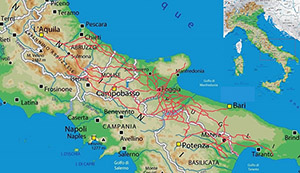 In addition to the large size, the livestock guardian dogs are characterized by dense coat, typically made up of thick, woolly undercoat and long-haired, to protect them in the harshest weather conditions, in particular: frost, snow and humidity. In summary they are perfectly adapted to the nomadic life .
In addition to the large size, the livestock guardian dogs are characterized by dense coat, typically made up of thick, woolly undercoat and long-haired, to protect them in the harshest weather conditions, in particular: frost, snow and humidity. In summary they are perfectly adapted to the nomadic life .
In Italy, as it has happened in other areas of the world, in different ways from time to time, the nomadic sheep-rearing has evolved in the transhumance.
The term is derived from the composition of two Latin words: "trans" ( = beyond) and "humus" (= ground, soil), it means the seasonal movement of livestock from high pastures towards the plains during the winter and vice versa during summer, travelling hundreds of miles .
This type of grazing characterizes the Apennines mountains of central-southern Italy even since the age of copper (4500 BC) and it acquired during the time a fundamental economic importance to the point to be governed by law during the Roman period (e. g. lex agraria, 111 BC)
The transhumance of central-southern Italy is also called "horizontal transhumance" to differentiate it from the "vertical transhumance" typical of the Alps: in the first case it is the movement of livestock, mainly sheep, over long distances, independently of the altitude and during a long period of time, weeks or months; in the second case, the movement of livestock, both ovine and bovine, is short and it consists of an altimetric migration in the span of one or a few days.
The transhumance is typical of the countries of the Mediterranean basin, in the territories of southern Europe from Portugal until the Balkan peninsula: an area generally characterized by rainy/snowy winters and hot summers ensuring abundant grazing at high altitude.
These areas correspond exactly to the areal of breeding and diffusion of the dog breeds specialized in guarding the liveflock, breeds surprisingly similar to each other, without doubt from monophyletic origin: large dogs with thick, wholly coat totally or mainly white.
The transhumance of central and southern Italy winds along pathways called "tratturi" (singular = "tratturo", from Latin "trahere" = to lead, to drive), predominantly grassy slopes, sometimes more than 100 metres (328 ft) wide, connected to towns and villages by numerous sub-paths ("traturelli" = "little tratturi" e "bracci" = "arms") and interspersed with "riposi" (= "reposes"): temporary grazing areas .
The set of sub-paths and of secondary tracks forms a complex network, whose development exceeds 3000 km (1864 ml) in total and the importance, over the centuries, it was also cultural, ensuring the movement of knowledge, news, language items, artisanship, commercial activities.
For example, the longest and most important "tratturo" is that from L'Aquila conducts to Foggia, also called Tratturo Magno (= "Great tratturo") or Tratturo del Re (= "King's tratturo"): a path along 244 km (151 ml), wide in some places over 100 meters (over 330 ft .) 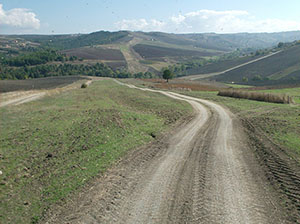 The transhumance, both in Italy and elsewhere, is a sort of organized nomadic sheep-rearing, however the risks faced by men and animals remain high: long journeys through mainly wild or poorly anthropized territories expose the livestock to attacks by predators or thieves, therefore the presence of one or more guard-dogs is indispensable.
The transhumance, both in Italy and elsewhere, is a sort of organized nomadic sheep-rearing, however the risks faced by men and animals remain high: long journeys through mainly wild or poorly anthropized territories expose the livestock to attacks by predators or thieves, therefore the presence of one or more guard-dogs is indispensable.
For this reason, all over the world the figure of the livestock guard-dog is inseparable from the concepts of transhumance or extensive sheep-rearing, moreover the high number of sheep ensures the maintenance of the same great guard dogs, because the main source of proteins destined to the dogs derives just from whey: the transhumant sheep-rearing and the active protection of the sheep are closely interdependent.
The necessity and the efficiency of guard-dogs protecting the flock has been demonstrated amply (Coppinger et al. 1988): the presence of the dogs reduces the slaughter of sheep from the predators by 70 % or more.
To describe accurately the Abruzzese Mastiff is first necessary to provide some clarification: there is in fact a fair confusion between "Abruzzese Mastiff " and "Maremmano-Abruzzese Sheepdog", known also by the incorrect names of "Maremmano Sheepdog"or "Maremma Dog" in Anglo-Saxon countries.
The FCI (Fédération Cynologique Internationale) recognizes the breed called "Cane da Pastore Maremmano-Abruzzese" ("Maremmano-Abruzzese Sheepdog", standard N° 201 1981), following on the fusion between the names "Pastore Maremmano" and "Pastore Abruzzese" in 1958. Generally, in the world, the names "Maremma dog" or "Maremmano dog" refer to the breed recognized by the FCI; however, the terms "Maremmano" or " Maremma " are inaccurate and historically misleading.
The Maremma is a large area between Tuscany and Lazio regions, the borders are difficult to define, extended along the coast of Ligurian and Tyrrhenian Seas and to the west of the range of Appennini Mountains
The word "Maremma" is derived from the Latin term "maritima" (= "marine territory") or from the Castilian "marisma" (= "swamp"), in both cases it is evidenced the nature of a difficult territory because of the high humidity, which has made it the subject of important drainages ever since ancient times.
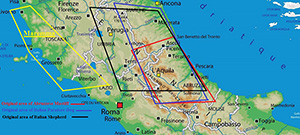 In this area, as in the rest of Tuscany region, there is no historical evidence of breeding of the great white guard-dogs.
Also the heart of Italian sheep-rearing economy, based on transhumance, and therefore on the use of guard-dogs, was concentrated along the central-eastern flanks of the Appennini Mountains range (Abruzzo region and vicinity); in spite of this the Tuscanian cynophilists were the first to take into account the watchdogs of Abruzzo from the sporty point of view, making them known also in England during the XIX century (e. g. Grand National Dog Show in Nottingham, october 1872). Today it can be stated that the name "Maremma dog" is historically imprecise because the Maremma, therefore the Tuscany, was area of diffusion only but not of origin/breeding of this canine lineage (Breber , 1977).
In this area, as in the rest of Tuscany region, there is no historical evidence of breeding of the great white guard-dogs.
Also the heart of Italian sheep-rearing economy, based on transhumance, and therefore on the use of guard-dogs, was concentrated along the central-eastern flanks of the Appennini Mountains range (Abruzzo region and vicinity); in spite of this the Tuscanian cynophilists were the first to take into account the watchdogs of Abruzzo from the sporty point of view, making them known also in England during the XIX century (e. g. Grand National Dog Show in Nottingham, october 1872). Today it can be stated that the name "Maremma dog" is historically imprecise because the Maremma, therefore the Tuscany, was area of diffusion only but not of origin/breeding of this canine lineage (Breber , 1977).
The breed today officially recognized as Cane da Pastore Maremmano-Abruzzese was selected from a population of working dogs identifiable into the Abruzzese Mastiff. .jpg) It is reason for lively discussions among cynologists: if the Maremmano-Abruzzese Shepherd and the Abruzzese Mastiff are two types - respectively "sporty" and " working" of the same race, or whether they are to be considered separate breeds .
It is reason for lively discussions among cynologists: if the Maremmano-Abruzzese Shepherd and the Abruzzese Mastiff are two types - respectively "sporty" and " working" of the same race, or whether they are to be considered separate breeds .
There are different geographical types of Abruzzese Mastiff, and this makes difficult to clear a morphological separation from the Maremmano-Abruzzese Shepherd, however it is clear that the Mastiff represents a primitive population and working genuinely and that the average of the morphological differences (e. g. size, general structure of the skull, texture of hair) seems to indicate the separation between the two breeds.
In summary: despite the Abruzzese Mastiff is not officially recognized by the FCI, it is historically and genetically the real ancestor of the "Maremmano-Abruzzese Shepherd" and it must be considered a distinct breed.
The ancient original area of the great white guard-dogs is Central Asia: from this region the ancestors of the typical livestock guard-dog breeds today recognized (e. g. Kuvasz, Slovensky cuvar, Mastin De Los Pyreneos, Chien de montagne des Pyrénées, ecc.) came, so the distant ancestors of the Abruzzese Mastiff came from there too.
Each breed belonging to this group evolved later in the breeding territories, acquiring little by little its identity.
The Abruzzese Mastiff has fully innate protective instinct towards the sheep and - if necessary - also in relation to other small pets, not only in the case of predation by wolves or bears, but also at any time of vulnerability or difficulty, for example if a ewe gives birth or is injured. 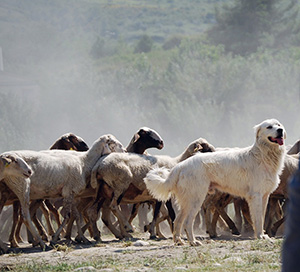 The presence and the employment of this breed in the territory of central-southern Italy is demonstrated by historical basis.
The presence and the employment of this breed in the territory of central-southern Italy is demonstrated by historical basis.
The Latin writer Marcus Terentius Varro (116 BC - 27 BC ) has handed down in his work "De Re Rustica" (About the Agronomic argument) an accurate description of the "Canis pastoralis" (...):
Facie debent esse formosi, magnitudine ampla, oculis nigrantibus aut ravis (
) "capitibus et auriculis magnis ac flaccis, crassis cervicibus ac collo" (...) cauda crassa, latrato gravi, hiatu magno, colore potissimum albo, quod in tenebris facilius agnoscuntur, specie leonina
"They have to be beautiful in appearance, of large physique, black or yellow eyes" (...) "big head and wide, soft ears" (...) "big tail, bark deep, wide span of mouth, white colour preferably, such it can be recognized in the darkness, leonine appearance."
The characters described by the Latin author are the same that can be recognized in today's Abruzzese Mastiff and that we can admire on the sculpture of Molosser (with cropped ears) preserved in the Belvedere Court of the Vatican Museums, which dates back to a period between 100 BC. and l AD., coeval of Varro
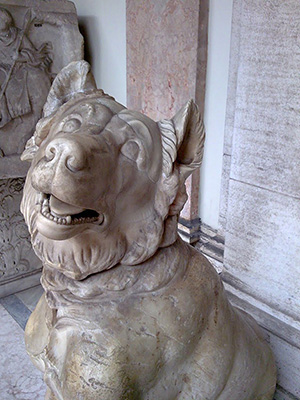 Another Latin author, Lucius Giunius Moderatus Columella ( 4 AD 70 AD), confirms the preference for the white colour of the shepherd dogs:
Another Latin author, Lucius Giunius Moderatus Columella ( 4 AD 70 AD), confirms the preference for the white colour of the shepherd dogs:
(...) "Pastor album probat, quoniam est ferae dissimilis, magnoque opus interdum discrimine est in propulsandis lupis sub obscuro mane vel etiam crepusculo, ne pro bestia canem feriat",
"The Shepherd prefer white colour, because it is very different from the wild beasts, and this diversity is needed when chasing down the wolves in the gloom of the morning or the dusk, so you do not hit the dog instead of the fair."
The Latin witnesses handed down an important detail: the typical sheepdog of the Italic territory, until the Roman period - or "Canis pastoralis" - it was exclusively a guard-dog : the Latin sheep-rearing economy was in fact based on the transhumance, practised in the central-southern mountainous territory already at that time: a dry and easily practicable than the swampy plains extended between Tuscany and Lazio regions.
Until the XIX century, the Abruzzese Mastiff was the typical dog of the "region of the tratturi", area of the Naples Kingdom made up by today's Abruzzo, Molise, Puglia, Campania and Basilicata regions.
The appearance, the role and the skills of Canis pastoralis have not changed in the course of the millennia: it is perfect to ward off predators from the flock .
I wrote "to ward off " because the survey of direct physical confrontation between the wolf and the Abruzzese Mastiff is limited: the Italian subspecies wolf (Canis lupus italicus, Linnaeus 1758) is adapted to a heavily anthropized habitat since ancient times, it does not form large packs but small family groups of two or three individuals, it has developed a great shrewdness and is able to assess when the number and strength of the mastiffs are too many to risk a sortie on the sheep.
Despite the Abruzzese Mastiff shows innate aggressiveness (fruit of continuous selection) against predators and in particular against the wolf, this is still a formidable opponent who can come off better against young or isolated dogs.
An Abruzzese Mastiff male at the age of five or six years (usually the pack leader) may have some possibilities to stand up to the wolf in a "hand-to-hand" fight ( Breber , 1977), however there is the ancient custom to protect the dogs with a spiked metal collar, said in Abruzzese dialect "vreccale" or "roccale " then considered "defensive weapon". During the past, also "offensive weapons" existed as the spiked pectoral defensive weapon
The pectoral represents a The Mastiff charges the enemy with the chest trying to throw back it to bite its stomach. (Breber, 1977) It is interesting to observe that the custom of the defensive spiked collar is archaic (see Photo 10) and widespread in all areas in which dogs are employed to fight the wolves, from Asia to the Iberian peninsula (see Photo 11)
Through the centuries we have received numerous iconographic evidences about the employment and constant morphology of the Abruzzese Mastiff.
One should not forget that the morphological homogeneity of Abruzzese Mastiffs always has been and it is still considered of secondary importance compared to the working skills: the morphology and the beauty are a direct consequence of the necessary working skills of the dog.
The empirical relationship between form and ability helped the farmers to select these working dogs; today we can speak about an empirical "standard" summarized in these points: large mass (over 80 kg - 176 lb for the males); powerful and broad head; large chest; absolutely white coat.
Despite the risk represented by crosses that may undermine the working skills, the farmers of Abruzzo region in the past gave "new blood" in the Abruzzese Mastiff by means of crosses with another ancient Italian breed: the Cane Corso (Standard FCI n° 343; 24 giugno 1987).
The Cane Corso, indigenous of Puglia region and with the same ancestors of the Neapolitan Mastiff, was used during the past to capture wild cattle and wild boars; the contribution of this breed has helped to increase the fighting spirit and the generosity of the Abruzzese Mastiff.
However the genetic supply of Cane Corso has caused the appearance of black dappled dogs.
In the past, the spotted or reddish exemplars sometimes were eliminated drastically, however this was not a rule: even today, in some areas, the existence of black dappled Abruzzesi Mastiffs is admitted; these examples are employed to guard the farm exclusively, they are not considered suitable to livestock guarding; they are called "Mezzocorso" ("Half a Corso") or, because of the black and white coat, "Domenicani" (= "Dominican variety") recalling the black and white habit of the Dominican friars.
The typical diet for Abruzzese Mastiffs consists of whey, bread, sometimes bran.A surprising aspect, about the physio/behavioural sphere, is the refusal from the Abruzzesi Mastiffs to feed on the flesh of sheep: it is probably an heritage that comes from both genetic selection and imprinting, these dogs are missing absolutely predatory instinct and any tendency of aggression towards the ovines.
The physiological capacity of the Abruzzese Mastiff to metabolize easily the starches could be an indication of the archaic genetics of the breed: in the light of recent studies (Axelsson et al., 2013) the acquisition of the capacity to digest easily the starches, compared to the wolves and to the other representatives of the genus Canis, is a crucial passage in the domestication of first dogs.
The work on field is carried out by a variable number of dogs: usually the considered ratio is ewes/Dogs = 100/1, but the number of dogs may be various and higher if the sheep have to move through areas particularly rich in predators, as it is can be observed in Italy from region to region: in Abruzzo region, for example, it is employed a number of dogs higher than in Tuscany or in Lazio regions (Maurizio Martial by direct conversation).
The Abruzzese Mastiff is strictly a working breed; being not officially recognized, it is not protected by national boards (ENCI - FCI) and it is maintained in purity by enthusiasts, farmers and shepherds; and the only one attempt at protection dates back to a legislative proposal of Abruzzo region in 2002, proposed by the Italian Abruzzese Mastiff Club (CIMA ).
Italian Paratore Dog (Cane Paratore Italiano)
The Italian Paratore Dog is also called "Cane Toccatore" ("Toucher Dog" ) because it drives the sheep with fast and light touches of the muzzle, in fact this breed is distinguished by its care in herding the ewes.
In Italian the term "paratore " occurs in the zootechnical context to indicate the sheepdog specialized to herd sheep and, when necessary, cattle.
Unlike what happened about the Abruzzese Mastiff, the historical evidences about the herding dogs in Italy are almost absent.
The Latin texts above quoted allow us to deduce that in the past, until Roman times, there were no dogs specialized in herding in Italic territory: the ancient Canis pastoralis was exclusively a guard-dog.
A first clue is deducible from the etymology of the term "paratore": in the classical Latin the verb "parare" means "to prepare", "fit out", in this case it seems there's no logical connection with to the work of the dog.
However, considering the Vulgar Latin of the late Middle Ages (after X century approximately), the verb takes the meaning of "to push forward" or "to stand in front of ": a meaning which still today remains in some dialects of Northern- East Italy; the same philological root is in the term "parade".
"Paratore" is therefore the sheepdog who leads the sheep in determined directions and regulates their movement.
The historical events seem to confirm the medieval origin of this dog breed native of central Italy: In North-central Italy, from the XIII - XIV centuries, the development of commercial trades and economic activities in the towns attracted from the countryside a great number of free farmers, lured by the opportunity to embrace the profitable activities of trade and handicraft.
This migration led to a conflict between rising city's economy and feudal economy based on rural activities; the feudal lords were the first to suffer the economic damage and, to hold the rural population, had to modify deeply the relationship of dependency through large concessions: the emphyteusis, or the right of ground exploitation in the long-term, and the formation of the first associated managements that cause the birth of the first estates.
Consequently, the extension of lands destined to the cultivation grew thanks to drainage works and deforestation, also the number of large predators declined dramatically as a result of systematic hunting.
Because the pastures and farmlands alternated closely, it needed a new aid in the work of the farmer so that the livestock were contained within the pastures, without trespassing and therefore without damaging the nearby cultivations: in this period the first specialized herding dogs appear in Italy .
In order for the herding dog can be considered as such, it must show morpho/functional characters very precise: it is medium or medium-small sized, typically and necessarily - as we shall see "lupoid" (wolf-like) , fast, agile and intelligent, able to develop a real empathy with the owner/conductor in order to interpret and execute his orders quickly, but also endowed with decisional autonomy and resolutive skill.
Some works of art of the XIV century testify the presence of the first dogs with the morphological characters of herding dogs:
The herding dog is needed to the permanent or semi- permanent sheep farming as the presence of the guard-dog is needed to the transhumance.
From the ethological perspective, the herding dog can be considered the antithesis of the guard-dog.
When the dogs gather and drive the livestock or separate a part of the flock, they use the same tactics - with some difference from breed to breed - used in Nature by the wolves hunting the large herbivores.
The activity of the herding dog is a kind of mimed hunting, missing cruel attitudes .
The flock reacts and moves in front to the tactical and to the "lupine" appearance of the herding dog, therefore the final result is derived from the encounter of two ethological modules: the one (partially) predatory of the dog and the one of escaping of the sheep.
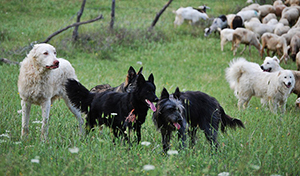
The two types of sheepdogs guarding and herding - have aptitudes antithetical (Breber, 1977): while the watchdog absolutely mustn't have predatory instinct, the herding dog performs its task by mimicking the activity of predation: the cooperation between guard-dogs and herding dogs is primarily determined by habit, training and the adaptable intelligence of the dogs.
It's possible that a guard dog, that has never seen a herding dog, attacks this identifying as predator (Coppinger, 1982).
According to oral tradition, to increase the capacity of predatory instinct, the Italian Paratore Dog was crossed with wolves in the past; an image, dating back to the '50s, could confirm this hypothesis.
However only a genetic analysis could confirm - or disprove - the hypothesis; there is evidence that, from a cross sheepdog/wolf, there is no security to obtain, within a few generations, reliable herding dogs: it is needed a long and careful selection to quell the predatory instinct inherited from the wolf and to get a good trainability
Another contribution to the formation of the breed may have come from breeds of Spanish origin.
Central-southern Italy was under Spanish domination since the XIV century and the commercial and cultural exchanges between the Italian and the Iberian peninsula were constant until the XVIII century.
In Italy were introduced Merino breed ewes and, as it happened later in other parts of the world, in the wake of these sheep also herding dogs arrived, probably similar to the Catalan Sheepdog.
It is not excluded that the Paratore Dog has also an ancestry of the Spitz type.
The Mastiffs and the Herding Dogs were often accompanied by small dogs, named "pumetti" or "pomini" in the dialects of central Italy. The name derives from a distortion of the term "pomerania", it seems clear that these little, brisk and noisy dogs descend from northern European spitz introduced in Italy between the XVI and XVII century
The allele "Merle", determining the dilution of colour of the coat in the heterozygotic form "Mm" or in the depigmentation in the homozygotic form "MM", occurs rarely in the Italian Paratore Dog and with mild effects, therefore, because the presence of the allele "Merle" is typical of the "Collie-like" dogs - spread mostly in the British Isles and in southern Europe through Spain, France, northern Italy, Germany and Hungary - it seems probable that the Italian Paratore Dog was not crossed in recent times with herding dogs of this group.The presence of indigenous wolf-like dogs is confirmed in the Italian peninsula since Neolithic times: in 2009, a tomb was found near Mantova (Northern Italy): the tomb of a hunter, buried with his dog that was very similar to a small wolf (see web reference in bibliography).
In these ancient native dogs it would be recognized the farthest origin of the Paratore Dog The progressive selection as a working function closely and the environment have finally determined the functional homogenization of the breed.
The Paratore Dog is typically lupoid (wolf-like), medium or small-medium sized (15 kg - 25 kg / 33 lb 55 lb, on average); the coat is short or semi-long , rough and "caprine"; the basic colour is grey with various shades, in some cases all black.
